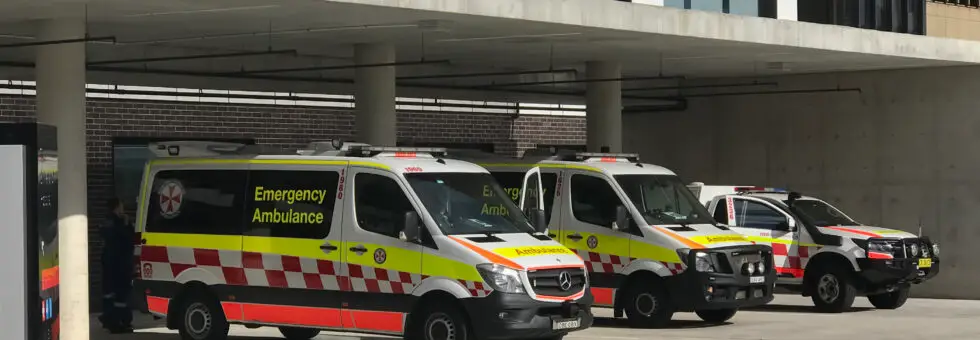
Introduction
Emergency transportation and paramedic services can be extremely expensive – and if you don’t have ambulance cover, you could be left to pay the bill in full. In Australia, a single ambulance trip can cost hundreds or even thousands of dollars, depending on where you are located and the type of emergency you’re in.
Ambulance cover is a way to financially protect yourself from these costs, and for many it can turn out to be an invaluable safeguard. Let’s learn more about different ambulance insurance plans, your coverage options, whether you should take out a policy by itself or go for private health insurance, and other considerations to help you decide if getting ambulance cover in Australia is worth it.
What is ambulance cover?
If you have an ambulance cover policy, it will pay for your emergency and, in some cases, non-emergency transportation costs. Unlike other health services, ambulance services aren’t covered by Medicare. That means if you rely solely on the public healthcare system, you could face substantial fees if and when you need emergency transportation. Here’s what this type of plan usually includes:
- Emergency transport: Costs of transportation to a hospital in an emergency.
- Non-emergency transport: Transfer between facilities or for medically necessary appointments, depending on your policy.
- Air and sea ambulance: Some policies also include non-road ambulances like air and sea transport.
Why ambulance cover isn’t automatically included by Medicare
Medicare covers many essential healthcare costs for Australians, but it doesn’t extend to ambulance services. Instead, every state and territory manages its ambulance services independently, and policies for ambulance fees differ depending on where you are located.
This can make it very complex to know what type of cover you need – or if you even need it at all. But ignore the issue at your peril; if you haven’t looked into ambulance insurance plans then you could be left footing the bill yourself.
Cost of ambulance services in Australia

There’s no one-size-fits-all fee for ambulance trips. Depending on the state/territory and service required, the actual cost will vary.
In Victoria, for example, emergency road transport fees are $1,396 in metro areas and $2,059 in regional and rural areas for a single trip. Non-emergency fees are much cheaper, but can still end up being several hundred dollars.
Air and sea ambulance services, on the other hand, can run into the thousands or even tens of thousands of dollars, especially if you’re in a rural area where helicopters or chartered medical flights are necessary. Some states also have a per-kilometre charge, which can add up quickly if you are far away from the nearest hospital.
How does ambulance cover work?
When you have ambulance insurance, your provider will pay for an ambulance service if you ever need one. First, you’ll need to choose an ambulance cover policy that fits your needs – either as a standalone plan or bundled with private health insurance.
When you receive your ambulance bill, you can submit it to your insurer for reimbursement. In some cases, your insurer will pay the ambulance provider directly. However, be mindful of your policy’s details and always read the PDS. Some ambulance cover plans have waiting periods for non-emergency services, or they might cap benefits for certain types of transport (e.g. air and sea ambulances).
Who needs ambulance cover?
- Residents in states/territories with ambulance fees: If you live in a part of the country where ambulance services aren’t covered (such as Victoria, Western Australia and New South Wales), having this type of cover can help you avoid unexpected bills.
- Frequent travellers: If you travel often, especially interstate, then Australia-wide ambulance cover will give you total peace of mind. Most states have reciprocal agreements, but the specifics of the cover will vary between private health insurers.
- If you have limited emergency savings: Emergency ambulance services can put a serious strain on your budget. If you think you might struggle to cover these fees in the event of an emergency, ambulance cover could be a wise investment.

Portability
Don’t re-serve waiting periods when you switch to a new health fund or policy
“John was immediately covered for a hip replacement in private hospital because he had already served his waiting periods for joint replacements on his old policy”
Types of ambulance cover available
Understanding the types of ambulance cover can help you choose the right policy for your needs. Here’s a guide to ambulance cover in Australia:
1. Standalone ambulance cover: This is a separate policy from hospital or extras cover. You can expect to pay around $5 to $10 per month, depending on the provider.
2. Bundled with health insurance: Most private health insurance policies include some level of ambulance cover with their hospital, extras and combined cover. Check your existing policy details, as not all plans include ambulance services and waiting periods might apply.
3. Government-provisioned ambulance cover: In some states, the government takes care of ambulance cover for residents:
- Queensland and Tasmania: Ambulance services are fully funded by the state, meaning you don’t need separate cover.
- Victoria and Western Australia: You pay a fixed fee for ambulance services.
- ACT, New South Wales, Northern Territory and South Australia: You pay a callout fee plus a per-kilometre charge unless you have an ambulance cover policy.
Ambulance cover vs private health insurance
If you already have private health insurance, you might already have ambulance cover included. However, don’t rely on that being the case without first reviewing your policy’s details. While many hospital and extras policies include ambulance cover, they might have limitations.
Most policies, for example, have short waiting periods (i.e. one day for emergency cover and longer for non-emergency cover). Other policies might not cover inter-hospital transfers or air and sea ambulance services, which are more common in rural and remote parts of the country. Then there’s the reality that certain policies only cover emergency transport, meaning you’ll need additional cover for non-emergency or scheduled ambulance services.
Given these limitations, it’s a good idea to review your health insurance policy and decide if a standalone ambulance cover plan might be a better fit.
Choosing the right ambulance insurance plan
First, you’ll need to decide if you need emergency-only cover or a more comprehensive plan that includes non-emergency transport and air/sea ambulance options. If you live in Queensland or Tasmania, be aware that government-funded ambulance services might mean you don’t need separate cover. But if you frequently travel interstate, extra cover may be useful.
It could also be in your best interests to look for policies that offer family-wide cover to make sure your dependents are covered under a single plan. Bottom line: comparing ambulance cover options carefully can help you find the best-value plan for your needs.
So, is ambulance cover worth it?
For most Australians, the peace of mind you’ll get from ambulance cover is well worth the relatively low cost. Given the high price of emergency transportation, even a basic plan can protect you against unexpected bills.
To learn more about ambulance cover or finding a private health insurance plan that fits your needs, contact the experts at Fair Health Care Alliance or call 1300 955 691 today.

Aaron Savrone, founder of Fair Health Care Alliance (FHCA), is a health insurance expert with over 15 years of experience. Specializing in transparent, customer-focused advice, Aaron launched FHCA in 2017 to address the lack of genuine care in the health insurance comparison space. With a commitment to simplifying complex policies and data, Aaron and the team have earned FHCA top ratings and awards, including a 5-star Google Review score from hundreds of reviews and Best Insurance Comparison Website in 2023 and 2024 (ProductReview).







